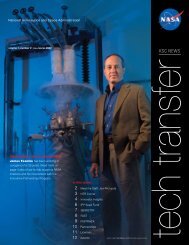2006-2007 - Kennedy Space Center Technology Transfer Office
2006-2007 - Kennedy Space Center Technology Transfer Office
2006-2007 - Kennedy Space Center Technology Transfer Office
- No tags were found...
You also want an ePaper? Increase the reach of your titles
YUMPU automatically turns print PDFs into web optimized ePapers that Google loves.
Automating Range Surveillance Through Radio Interferometry and FieldStrength Mapping Techniques<strong>Space</strong> vehicle launches are often delayed because of the challenge of verifying that the<strong>Space</strong>port/RangeSituational range is clear, and such delays are likely to become more prevalent as more and more newAwareness spaceports are built. Range surveillance is one of the primary focuses of Range Safetyfor launches and often drives costs and schedules. As NASA’s primary launch operationcenter, <strong>Kennedy</strong> <strong>Space</strong> <strong>Center</strong> is very interested in new technologies that increase the responsivenessof radio frequency (RF) surveillance systems. These systems help Range Safety personnel clear therange by identifying, pinpointing, and resolving any unknown sources of RF emissions prior to eachlaunch.Through the Small Business Innovative Research (SBIR) program, Soneticom, Inc., was awarded twoPhase I contracts and has demonstrated an RF surveillance system that dramatically increases theability to quickly locate and identify RF emitters. The system uses a small network of nodes(Figure 1), radio interferometry (RI) algorithms, time difference of arrival (TDOA) algorithms, andfield strength mapping techniques to provide the quick response.In their first Phase I SBIR project, Soneticom showed that the RI/TDOA techniques are feasible forlocating RF emitters and met three technical objectives. The first objective was to demonstrate RIalgorithms that can produce an image of an area and map specific RF activity within that area. TheRI algorithms consistently located RF emitters within 100 meters. The computational complexityof these RI algorithms, or more specifically, group delay interferometry algorithms, exceeds thatof similar TDOA techniques by orders of magnitude. The second objective was to demonstrateRF algorithms that can identify image differences based on a set of established criteria. The thirdobjective was to demonstrate TDOA algorithms to help capture an RF image of an area andgeolocate targeted RF emitters. However, the TDOA algorithms proved to be unsuitable for theautomated background subtraction techniques used to distinguish the unknown emitters.Sensor 6Sensor 2Area ofInterestSensor 725 -30 kmSensor 3Figure 1. Example of an RF surveillance system network of nodes/sensors.62 Range Technologies













